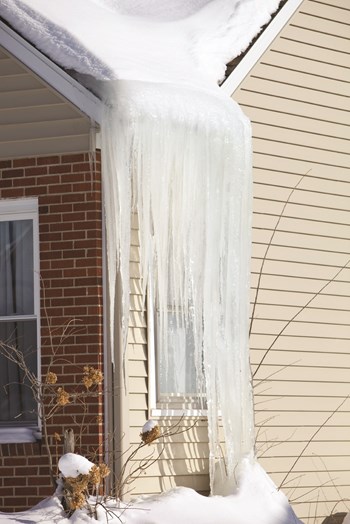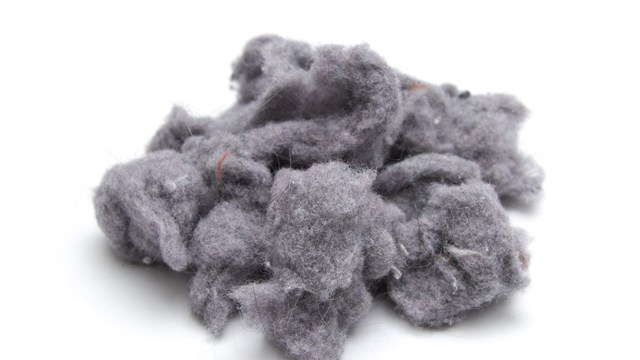
While ice damming on roofs is nothing new, the record-breaking snowfall of the 2014-15 winter was especially devastating in terms of ice dams. An ice dam is a ridge of ice that forms at the edge of a roof and prevents melting snow from draining off the roof. The water that backs up behind the dam can leak into a home and cause damage to walls, ceilings, insulation, and other areas.
“A combination of factors determines the root cause of the ice dam, and unfortunately, there is not always a quick fix,” says María Elena Solís, a commercial manager at Lemus Construction in Furlong, Pennsylvania.
Michael J. Sparks, an insurance agent with American Family Insurance, which has locations around the country, says, "In addition to ice damming, and of course frozen pipes, roof collapse is also common, along with slips and falls on ice, or snow not properly removed from walkways."
“The damage can be partial or total, depending on how severe the weather is and how soon the problem is detected,” Solís says. “The repair or replacement can be even more expensive and inconvenient if actually undertaken during the winter.”
Alan R. Geisenheimer, CIC, president and founder of the Geisenheimer Agency in Fair Lawn, says, “Repairs to the interior usually consist of removing the damp or damaged sheet rock--and possibly the wet insulation—and replacing and painting, or wallpapering.”
Avalanche!
As to the question of how to deal with such winter damage from a practical perspective, “Ice dams must be dealt with before you can install roofing shingles,” says Dennis Deribin, owner of Capitol Roofing Company in Orange. “This is the most important part of the roofing process, and the part you cannot see. Much, in great detail, has to be done first, and this is more often than not the place where corners are cut to save the installer money and time.”
“If there is a rise in the temperature,” Deribin says, “and rain and water come in, ceilings can fall, you can flood the basement. You’ll end up having to remove the roof and start from the beginning.”
“You have to first consider the orientation of the unit or building,” Solís says. “If it is facing north, this will definitively have more influence upon the situation at hand. Secondly, there has to be a balance between ventilation and insulation in the attic or crawl space. The objective is that it is as cold as the outside. To address the ventilation, proper income ventilation through the soffits, and outcome through ridge vents or louvers, is a must.”
Expanding on the importance of insulation, Solís says, “Nowadays, it’s recommended that you have twenty inches compared to twelve: that was the minimum accepted up to a few years ago. We also have to consider the original components installed by the builder: leak barriers, plywood, sheet rock on the ceiling, etc. Any and all defective or substandard components play an important role in the overall roofing system.”
“In order to minimize the potential damage to the roofing system, the best approach is to be proactive,” Solís says. “Have a preventive maintenance program in place that will definitively address any and all potential water infiltrations. In those worst case scenarios, where we do have ice damming even after implementing such a program, there are other options to consider, such as removal of snow build-up, heating cables, roof melt tablets, or de-icing agents that will not damage the shingles.”
On the subject of safeguards, Barbara Lombardi, claims manager at USI Insurance Services (formerly BHB Insurance) in Toms River, tells us that “Ideally, the temperature in the attic should be close to the temperature of the outside air. Electric outlets, plumbing vents, furnace stacks, and bathroom vents can all allow heat to escape into an attic. Underlayments, protect the wood deck from ice dams by creating a water-tight barrier between the shingles and the roof deck. However, they do not prevent ice dams from forming.”
Insurance Can Vary
Paul E Felsen, president at Felsen Insurance Services, in Denville, says, “The most common claims we see are incidents of water damage which are related to the melting of the ice dams, and the subsequent leaking of the water under the roof and into individual units. For example, the water will make its way down the wall and damage the ceiling.”
These claims can be very significant and result in large claims. “Insurance carriers tend to push for per-unit water damage and ice damming deductibles,” Felsen says. “Sometimes higher than the actual all-other-perils deductible, especially where past adverse experience dictates as such. We’ve had claims in excess of $15,000 per unit, involving multiple units, where a $5,000 per-unit deductible applied.”
Geisenheimer says that things get even more complicated if the damaged property is a condo. “It leaves us with a great degree of uncertainty as to who actually owns the walls,” he says. “For that, you need to see the condo documents. In an apartment or home, it’s relatively simple, as the apartment is owned by the landlord, and the house is owned by the homeowner.”
“There are two issues that may arise;” he says, “the first being, if the condo unit is rented, and the damage is serious enough to force the tenant to vacate, the lease may allow an abatement of the rent. If the condo unit owner does not have loss of rents coverage, he or she will lose out on the rental, and will still be obligated to the association for the maintenance fees and to the town for the taxes. The second is: if the repair is not made quickly, mold will have a chance to grow, and that may cause bodily injury to the inhabitants, and may cause the insurance company to exclude coverage beyond what would be reasonable if the repairs were made quickly.”
Geisenheimer also tells us that many insurance companies use a per-unit or per-apartment deductible for ice damming. “So, if the ice damming damage extends to, for example, five units, the deductible may be twenty-five hundred dollars per unit, or per apartment. In fact, some insurance companies even charge this deductible over and above the regular policy deductible!”
Time is also a factor in determining whether or not to file claims related to winter roof-damage, and in determining whether they pay out. Lombardi says, “When an adjuster does his or her inspection, her or she will look to see if there's roof damage that needs to be addressed. As for addressing the cost of clearing the snow, the carrier may consider it under the claim, but bills would need to be submitted to the adjuster to review for possible consideration within a certain amount of time after the leak.”
“Installing new shingles will not prevent ice dams,” Lombardi warns. “Prevention can only be achieved when the entire roofing system is designed in anticipation of such damage being a possibility. This includes attic insulation and roof ventilation. Adding insulation to your attic minimizes the heat that escapes from the living space into the attic.”
As for roof ventilation: “Inevitably,” Lombardi says, “heat will get into your attic during winter months. Proper roof ventilation allows that heat to escape, preventing your roof deck from warming. The freeze/thaw process that results in ice damming is unlikely to occur on a roof that is properly ventilated.”
Marie Auger is a freelance writer and a frequent contributor to New Jersey Cooperator. Freelance writer Zak Block contributed to this article.






Leave a Comment